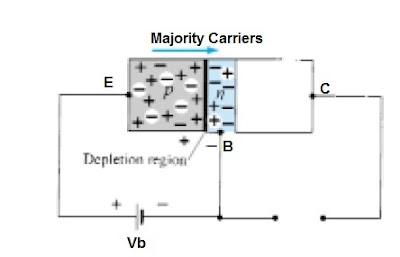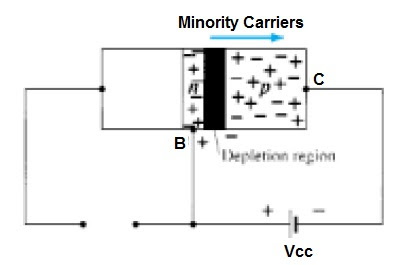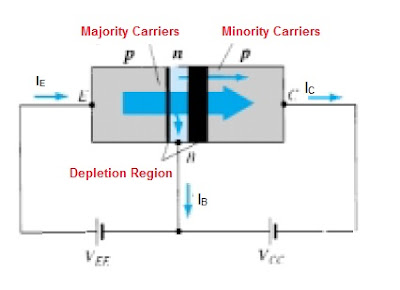In this post I will focus on the working principle of the Bipolar Junction Transistor assuming that you are already aware of the construction details of the BJT or simply Transistors.
The basic operation of the transistor will be described using the pnp transistor. The operation of the npn transistor is exactly the same if the roles played by the electron and hole are interchanged. In the figure below, the pnp transistor has been drawn without the base-to-collector bias. This situation is similar to that of the forward-biased diode. The depletion region has been reduced in width due to the applied bias, resulting in a heavy flow of majority carriers from the p- to the n-type material.
As obvious from the figure above, Emitter to Base junction is forward biased, therefore majority carriers i.e. holes from the Emitter side to the Base side will start flowing and hence a current will set up from Emitter to Base.
Let us now remove the Emitter to Base bias of the pnp transistor as shown in figure below. Mind the similarities between this situation and that of the reverse-biased diode. Recall that the flow of majority carriers is zero, resulting in only a minority-carrier flow, in case of reversed biased diode.
Thus for the above situation only minority carriers i.e. holes flows from the n-side to the p-side. To summarize, we can say that one p-n junction of a transistor is reverse biased, while the other is forward biased under normal operating condition.
Now we will combine the two scenarios discussed above. In figure below both biasing potentials have been applied to a pnp transistor, with the resulting majority- and minority-carrier flow indicated. Note the widths of the depletion regions in the figure, indicating clearly which junction is forward-biased and which is reverse-biased.
As indicated in figure, a large number of majority carriers i.e. holes will diffuse across the forward-biased p-n junction into the n-type material. The question then is whether these carriers will contribute directly to the base current IB or pass directly into the p-type material.
Since the sandwiched n-type material is very thin and has a low conductivity, a very small number of these carriers i.e. holes will take this path of high resistance to the base terminal. The magnitude of the base current is typically on the order of microamperes as compared to milliamperes for the emitter and collector currents. The larger number of these majority carriers i.e. holes will diffuse across the reverse-biased junction into the p-type material connected to the collector terminal as shown in the figure. The reason for the relative ease with which the majority carriers can cross the reverse-biased junction is easily understood if we consider that for the reverse-biased diode the injected majority carriers will appear as minority carriers in the n-type material. In other words, there has been an injection of minority carriers into the n-type base region material. This is the reason, holes which arrived in n-type material will not go as base current IB rather will cross reversed biased np junction to share collector current IC.
Now after understanding this much we are able to get some mathematical relationship. Applying Kirchhoff’s current law to the transistor, we obtain
IE= IB + IC
Thus we observe that emitter current is the sum of the collector and base currents.
The collector current in turn is made up of two components i.e. the majority and minority carriers as indicated in figure above. The minority current component is called the leakage current and is given the symbol ICO (IC current with emitter terminal Open). The collector current, therefore, is determined in total by equation,
IC= ICmajority + ICOminority
For general-purpose transistors, IC is measured in milliamperes, while ICO is measured in microamperes or nanoamperes. ICO, like Is for a reverse-biased diode, is temperature sensitive and must be examined carefully when applications of wide temperature ranges are considered. It can severely affect the stability of a system at high temperature if not considered properly.


